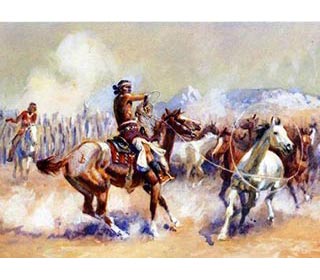Navajo Land
The Navajo Native Americans lived in harmony with the land which was emphasized by the their culture, religion and beliefs. The idea of an individual person having exclusive use of a particular piece of land was completely alien to Native Americans. Navajo Land - Ownership?
The Navajo fought, as communities, with other tribes over hunting rights to their territory. But the "right" to the land was very different from the legal terms understood by the white settlers relating to individual ownership. The Navajo Indians had no concept of "private property," as applied to the land, but were soon to experience this European idea, through the constant encroachment on the tribal territories and Navajo land. Navajo Land - Wars and Conflicts
The Navajo joined forces with the Pueblo tribe and forced the Spaniards out of the area following the Pueblo Revolt of 1680. In the 1780s, the Spanish sent military expeditions against the Navajo. The American Indian Wars is the name used in the United States to describe a series of wars, battles and conflicts between American settlers or the U.S. army, and the Native American Indians before and after the American Revolutionary War. In the 1840s the United States Army arrived in the area during the Mexican American War. There were many conflicts between the Navajo and the US. Treaties were made and then broken. Navajo Land - Moved to the Reservation
The Navajo conflicts continued until Colonel Kit Carson conducted an expedition into Navajo land and receive their surrender on July 20, 1863. Starting in the spring of 1864, around 9,000 Navajo men, women and children were forced on 'The Long Walk' of over 300 miles (480 km) to a reservation at Fort Sumner in New Mexico. Navajo Land - Dawes General Allotment Act
The Dawes General Allotment Act was passed by Congress in 1887 which led to the break up of the large Indian Reservations and the sale of Indian lands, including Navajo lands to white settlers. | 